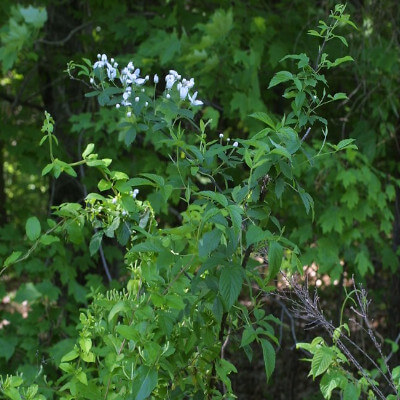
The Sawtooth Blackberry, or Rubus argutus, is a perennial, thorny plant belonging to the Rosaceae family. Native to the temperate regions of North America, it is particularly valued for its small, sweet, and juicy black fruits. The plant is easily recognised by its compound leaves, made up of three to five serrated leaflets – a feature that inspired its common name.
In its natural habitat, Rubus argutus thrives in sunny or partially shaded areas, such as meadows, forest edges, and open clearings. It can grow to a height of one to three metres, supported by arching stems often lined with fine thorns. The species adapts well to well-drained, nutrient-rich soils, making it both hardy and highly productive.
Flowering typically occurs from May to July, with delicate white or pinkish blossoms that attract a wide range of pollinators, including bees and butterflies. These flowers develop into clustered fruits that ripen towards the end of summer, between July and September. The blackberries provide an important food source for local wildlife and are also a key ingredient in many human culinary creations.
At the Au Bois Vert Botanical Garden, located near Ivato in Antananarivo, this plant offers both a visual and sensory delight. Visitors can observe Sawtooth Blackberry in a carefully managed and harmonious setting, where its natural growth contributes to the celebration of local biodiversity. After exploring the garden, guests are welcome to relax and enjoy a meal at the Au Bois Vert hotel’s restaurant, all while taking in the beauty of the surrounding greenery.
Plant use
Rubus argutus, commonly known as sawtooth blackberry, stands out not only for its visual appeal but also for its wide range of practical uses. Its berries are rich in vitamins C and K, dietary fibre, and antioxidants, making them a popular choice for those seeking a healthy diet. They can be enjoyed fresh, made into jams or jellies, or used in desserts such as pies and smoothies. In traditional medicine, the leaves and roots of the sawtooth blackberry are often prepared as a decoction for their astringent and anti-inflammatory properties. They have long been used to ease a variety of ailments, including digestive issues and skin inflammations. These uses highlight the plant’s longstanding role in herbal remedies, some of which are still practised in certain regions today. Beyond its culinary and medicinal benefits, Rubus argutus also plays an important ecological role. Its flowers provide nectar for pollinators, while the fruit serves as a food source for numerous birds and mammals. Additionally, the plant’s root system helps stabilise the soil, particularly in areas prone to erosion. Visitors to the Bois Vert Botanical Garden, located near the hotel’s lodge and restaurant, can discover the plant from multiple angles. Guided tours explore both its historical and modern applications and offer insight into how this species can be cultivated in local gardens. A walk among the Rubus argutus becomes a rich, educational, and sensory experience.
Key information
| Common name | Sawtooth Blackberry |
| Scientific name | Rubus argutus |
| Origin | North America |
| Natural habitat | Meadows, forest edges, well-drained soils |
| Life cycle | Perennial |
| Flowering period | May to July |


